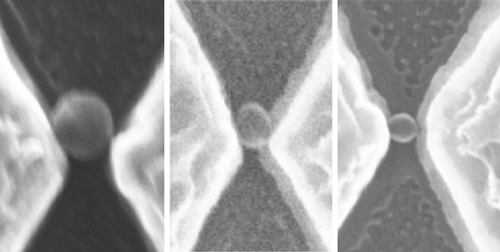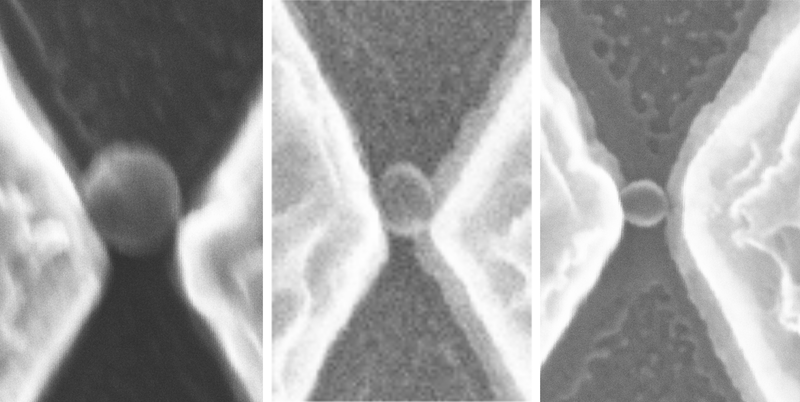How to Study a Speck of Dust
Ultrafine dust particles less than 100 nanometers (nm) wide can penetrate deep into the lungs and trigger respiratory diseases. Such particles cannot be detected by environmental monitoring techniques, but researchers have now demonstrated a way to spot and chemically identify particles as small as 34 nm, nearly 10 times smaller than the previous limit. The technique involves observing the infrared absorption spectrum of the particle when it is trapped in a tiny, bowtie-shaped cavity. The method could have many uses in diverse areas of monitoring for health and safety.
The most powerful methods to detect ultrafine particles exploit so-called surface-enhanced infrared absorption spectroscopy. The technique involves focusing an intense infrared beam into the region where a particle may be present and detecting the energy absorbed by the particle at specific wavelengths that are signatures of its composition. The term “surface enhanced” refers to an amplification of absorption achieved by focusing the light into a nanoscale structure such as a narrow slit in a metal foil. The confined space creates a strong interaction between the light and the particle surface. Using this method, previous studies have demonstrated an ability to detect particles as small as 240 nm in diameter.
Now a team led by Annemarie Pucci of the University of Heidelberg in Germany has taken the method a step further, achieving a nearly tenfold sensitivity improvement. Using a nanoscale bowtie-shaped structure, they dramatically increased the light intensity at the location of the particle.
Pucci and colleagues experimented with a crystalline wafer coated with a gold layer approximately 50 nm thick. They first etched out a bowtie-shaped aperture in the coating. The shape resembled a rectangle with two triangles intruding inward from its long sides and touching in the middle. The gold layer interacts strongly with infrared light, and the bowtie geometry increases the intensity of an incident beam at the meeting point of the two triangles.
To test their detection system, the researchers trapped single silica nanoparticles of varying sizes in the center of the bowtie. They then focused a broadband infrared beam into the structure while measuring the reflected light. The presence of a particle led to a strong absorption peak at a wavelength characteristic of silicon dioxide, the compound in silica, whereas the spectrum was largely flat in the absence of a particle.
The detection limit was 34 nm, but Pucci and colleagues found in numerical simulations that precise tuning of the shape of the bowtie should ultimately allow detection of 15-nm particles. The researchers also performed numerical calculations for particles made from several other materials, including plastic, and found that they could discriminate among materials based on the particles’ infrared spectra.
“This is a significant advance over previous detection methods,” says Georgios Ctistis, a specialist in photonic sensing at the Göttingen Laser Laboratory in Germany. “No one has managed to go down to such small dimensions, especially with single particles.” He also suggests that the work represents an impressive experimental achievement. “It’s very difficult to focus infrared radiation into such tiny volumes,” he says.
The team believes that the method could soon make a difference for practical monitoring and chemically identifying fine dust particles in the environment. “Ultrafine particles are the main constituents of airborne particulate matter” in air pollution, says Heidelberg team member Christian Huck, and they pose health risks. “With this technique,” he says, “it’s possible to make use of an incredibly large library of reference spectra when identifying materials, which is not possible with many other methods.” Huck says that the method might also allow identification of a single virus.
This research is published in Physical Review Applied.
–Mark Buchanan
Mark Buchanan is a freelance science writer who splits his time between Abergavenny, UK, and Notre Dame de Courson, France.





